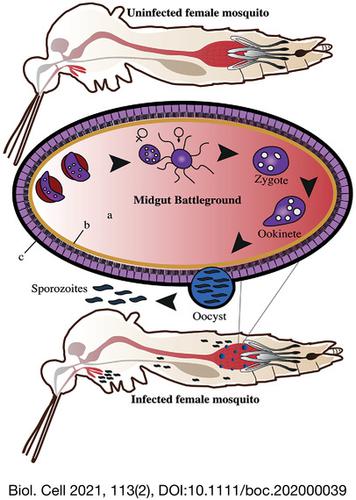当前位置:
X-MOL 学术
›
Biol. Cell
›
论文详情
Our official English website, www.x-mol.net, welcomes your
feedback! (Note: you will need to create a separate account there.)
Battleground midgut: the cost to the mosquito for hosting the malaria parasite
Biology of the Cell ( IF 2.4 ) Pub Date : 2020-11-23 , DOI: 10.1111/boc.202000039 Melika Hajkazemian 1 , Clément Bossé 1, 2 , Raimondas Mozūraitis 3, 4 , S Noushin Emami 1, 5, 6
Biology of the Cell ( IF 2.4 ) Pub Date : 2020-11-23 , DOI: 10.1111/boc.202000039 Melika Hajkazemian 1 , Clément Bossé 1, 2 , Raimondas Mozūraitis 3, 4 , S Noushin Emami 1, 5, 6
Affiliation

|
In eco-evolutionary studies of parasite-host interactions, virulence is defined as a reduction in host fitness as a result of infection relative to an uninfected host. Pathogen virulence may either promote parasite transmission, when correlated with higher parasite replication rate or decrease the transmission rate if the pathogen quickly kills the host. This evolutionary mechanism, referred to as 'trade-off' theory proposes that pathogen virulence evolves towards a level that most benefits the transmission. It has been generally predicted that pathogens evolve towards low virulence in their insect vectors, mainly due to the high dependence of parasite transmission on their vector-survival. Therefore the degree of virulence which malaria parasites impose on mosquito vectors may depend on several external and internal factors. Here we review briefly (I) the role of mosquito in parasite development, with a particular focus on mosquito midgut as the battleground between Plasmodium and the mosquito host. We aim to point out (II) the histology of the mosquito midgut epithelium and its role in host defence against parasite's countermeasures in the three main battle sites, namely a- the lumen (microbiota and biochemical environment) b- the peritrophic membrane (physical barrier), and c- the tubular epithelium including the basal membrane (physical and biochemical barrier). Lastly, (III) we describe the impact which malaria parasite and its virulence factors have on mosquito fitness. This article is protected by copyright. All rights reserved.
中文翻译:

战场中肠:蚊子寄宿疟疾寄生虫的成本
在寄生虫-宿主相互作用的生态进化研究中,毒力被定义为相对于未感染宿主,由于感染导致宿主适应性降低。病原体毒力可能会促进寄生虫传播,当与较高的寄生虫复制率相关时,或者如果病原体迅速杀死宿主则降低传播率。这种被称为“权衡”理论的进化机制提出病原体毒力进化到最有利于传播的水平。人们普遍预测病原体在其昆虫载体中会向低毒力进化,这主要是由于寄生虫传播对其载体存活的高度依赖性。因此,疟疾寄生虫对蚊子媒介的毒力程度可能取决于几个外部和内部因素。在这里,我们简要回顾 (I) 蚊子在寄生虫发育中的作用,特别关注蚊子中肠作为疟原虫和蚊子宿主之间的战场。我们的目的是指出(II)蚊子中肠上皮的组织学及其在宿主防御寄生虫的三个主要战斗部位的对抗措施中的作用,即 a- 管腔(微生物群和生化环境) b- 周营养膜(物理屏障) ),和 c- 管状上皮,包括基底膜(物理和生化屏障)。最后,(III)我们描述了疟原虫及其毒力因子对蚊子健康的影响。本文受版权保护。版权所有。特别关注蚊子中肠作为疟原虫和蚊子宿主之间的战场。我们的目的是指出(II)蚊子中肠上皮的组织学及其在宿主防御寄生虫的三个主要战斗部位的对抗措施中的作用,即 a- 管腔(微生物群和生化环境) b- 围营养膜(物理屏障) ),和 c- 管状上皮,包括基底膜(物理和生化屏障)。最后,(III)我们描述了疟原虫及其毒力因子对蚊子健康的影响。本文受版权保护。版权所有。特别关注蚊子中肠作为疟原虫和蚊子宿主之间的战场。我们的目的是指出(II)蚊子中肠上皮的组织学及其在宿主防御寄生虫的三个主要战斗部位的对抗措施中的作用,即 a- 管腔(微生物群和生化环境) b- 周营养膜(物理屏障) ),和 c- 管状上皮,包括基底膜(物理和生化屏障)。最后,(III)我们描述了疟原虫及其毒力因子对蚊子健康的影响。本文受版权保护。版权所有。即 a- 管腔(微生物群和生化环境) b- 围营养膜(物理屏障),以及 c- 管状上皮,包括基底膜(物理和生化屏障)。最后,(III)我们描述了疟原虫及其毒力因子对蚊子健康的影响。本文受版权保护。版权所有。即 a- 管腔(微生物群和生化环境) b- 围营养膜(物理屏障),以及 c- 管状上皮,包括基底膜(物理和生化屏障)。最后,(III)我们描述了疟原虫及其毒力因子对蚊子健康的影响。本文受版权保护。版权所有。
更新日期:2020-11-23
中文翻译:

战场中肠:蚊子寄宿疟疾寄生虫的成本
在寄生虫-宿主相互作用的生态进化研究中,毒力被定义为相对于未感染宿主,由于感染导致宿主适应性降低。病原体毒力可能会促进寄生虫传播,当与较高的寄生虫复制率相关时,或者如果病原体迅速杀死宿主则降低传播率。这种被称为“权衡”理论的进化机制提出病原体毒力进化到最有利于传播的水平。人们普遍预测病原体在其昆虫载体中会向低毒力进化,这主要是由于寄生虫传播对其载体存活的高度依赖性。因此,疟疾寄生虫对蚊子媒介的毒力程度可能取决于几个外部和内部因素。在这里,我们简要回顾 (I) 蚊子在寄生虫发育中的作用,特别关注蚊子中肠作为疟原虫和蚊子宿主之间的战场。我们的目的是指出(II)蚊子中肠上皮的组织学及其在宿主防御寄生虫的三个主要战斗部位的对抗措施中的作用,即 a- 管腔(微生物群和生化环境) b- 周营养膜(物理屏障) ),和 c- 管状上皮,包括基底膜(物理和生化屏障)。最后,(III)我们描述了疟原虫及其毒力因子对蚊子健康的影响。本文受版权保护。版权所有。特别关注蚊子中肠作为疟原虫和蚊子宿主之间的战场。我们的目的是指出(II)蚊子中肠上皮的组织学及其在宿主防御寄生虫的三个主要战斗部位的对抗措施中的作用,即 a- 管腔(微生物群和生化环境) b- 围营养膜(物理屏障) ),和 c- 管状上皮,包括基底膜(物理和生化屏障)。最后,(III)我们描述了疟原虫及其毒力因子对蚊子健康的影响。本文受版权保护。版权所有。特别关注蚊子中肠作为疟原虫和蚊子宿主之间的战场。我们的目的是指出(II)蚊子中肠上皮的组织学及其在宿主防御寄生虫的三个主要战斗部位的对抗措施中的作用,即 a- 管腔(微生物群和生化环境) b- 周营养膜(物理屏障) ),和 c- 管状上皮,包括基底膜(物理和生化屏障)。最后,(III)我们描述了疟原虫及其毒力因子对蚊子健康的影响。本文受版权保护。版权所有。即 a- 管腔(微生物群和生化环境) b- 围营养膜(物理屏障),以及 c- 管状上皮,包括基底膜(物理和生化屏障)。最后,(III)我们描述了疟原虫及其毒力因子对蚊子健康的影响。本文受版权保护。版权所有。即 a- 管腔(微生物群和生化环境) b- 围营养膜(物理屏障),以及 c- 管状上皮,包括基底膜(物理和生化屏障)。最后,(III)我们描述了疟原虫及其毒力因子对蚊子健康的影响。本文受版权保护。版权所有。











































 京公网安备 11010802027423号
京公网安备 11010802027423号